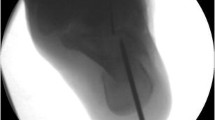Abstract
Introduction
Flexible flatfoot refers to the loss of the medial longitudinal arch of the foot on weight bearing and is associated with excessive heel eversion or forefoot abduction. Unless symptomatic, flexible flatfeet are best managed non-operatively. The calcaneo-cuboid-cuneiform osteotomy is a procedure that restores the anatomical shape of the foot without arthrodesis of the joints. Our study aims to evaluate the functional and radiological outcomes of patients treated with calcaneo-cuboid-cuneiform osteotomy in patients with planovalgus feet.
Methodology
A retrospective review of records and radiographs of patients with symptomatic flexible planovalgus feet, who were operated with the calcaneo-cuboid-cuneiform osteotomy by a single senior surgeon in a time period between April 2016 and July 2017 was done. The clinical and radiological outcomes were evaluated in 12 feet in 8 children.
Results
A total of 12 feet in 8 children were operated (6 males and 2 females). Average age of patients was 11 ± 1.27 years; average follow up was 14.7 months ± 2.7 months. Two patients had planovalgus feet secondary to spastic diplegia and 6 had idiopathic planovalgus feet. There was a statistically significant improvement in the pain score as well as the radiographic parameters in all the operated patients.
Conclusion
The calcaneo-cuboid-cuneiform osteotomy has potential to give good results for symptomatic planovalgus feet with minimal complications.






Similar content being viewed by others
References
Harris, E. (2010). The natural history and pathophysiology of flexible flatfoot. Clinics in Podiatric Medicine and Surgery, 27(1), 1–23.
Kim, J. R., Shin, S. J., Wang, S.-I., & Kang, S. M. (2013). Comparison of lateral opening wedge calcaneal osteotomy and medial calcaneal sliding-opening wedge cuboid-closing wedge cuneiform osteotomy for correction of planovalgus foot deformity in children. Journal of Foot and Ankle Surgery, 52(2), 162–166.
Caravaggi, P., Sforza, C., Leardini, A., Portinaro, N., & Panou, A. (2018). Effect of plano-valgus foot posture on midfoot kinematics during barefoot walking in an adolescent population. Journal of Foot and Ankle Research, 11(1), 1–9.
Carr, J. B., Yang, S., & Lather, L. A. (2016). PediatricPes planus: a state-of-the-art review. Pediatrics, 137(3), e20151230.
Rao, U., & Joseph, B. (1992). The influence of footwear on the prevalence of flat foot. A survey of 2300 children. The Journal of Bone and Joint Surgery. British, 74-B(4), 525–527.
Uden, H., Scharfbillig, R., & Causby, R. (2017). The typically developing paediatric foot: how flat should it be? A systematic review. Journal of Foot and Ankle Research, 10(1), 1–17.
Sachini, N. K., Kodithuwakku, A., Chander, H., & Knight, A. (2019). Flat feet: Biomechanical implications, assessment and management. Journal of Foot, 38, 81–85.
Rathjen, K. E., & Mubarak, S. J. (1998). Calcaneal-cuboid-cuneiform osteotomy for the correction of valgus foot deformities in children. Journal of Pediatric Orthopedics, 18(6), 775–782.
Mosca, V. S. (2010). Flexible flatfoot in children and adolescents. Journal of Children's Orthopaedics, 4, 107–121.
Sullivan, J. A. (1999). Pediatric flatfoot: evaluation and management. Journal of American Academy of Orthopaedic Surgeons, 7(1), 44–53.
Luo, C., Kao, H., Lee, W., Yang, W., & Chang, C. (2017). Limits of calcaneal lengthening for treating planovalgus foot deformity in children with cerebral palsy. Foot and Ankle International, 38(8), 863–869.
Mosca, V. S. (1995). Calcaneal lengthening for valgus deformity of the hindfoot: results in children who had severe, symptomatic flatfoot and skewfoot. Journal of Bone and Joint Surgery American, 77, 500–512.
Mourkus, H., & Prem, H. (2018). Double calcaneal osteotomy with minimally invasive surgery for the treatment of severe flexible flatfeet. International Orthopaedics, 42(9), 2123–2129.
Xu, Y., Cao, Y., Li, X., Zhu, Y., & Xu, X. (2017). Double calcaneal osteotomy for severe adolescent flexible flatfoot reconstruction. Journal of Orthopaedic Surgery and Research, 12(1), 153.
Cohen, B. E., & Ogden, F. (2007). Medial column procedures in the acquired flatfoot deformity. Foot and Ankle Clinics, 12(2), 287–299.
Moraleda, L., Salcedo, M., Bastrom, T. P., Wenger, D. R., Albiñana, J., & Mubarak, S. J. (2012). Comparison of the calcaneo-cuboid-cuneiform osteotomies and the calcaneal lengthening osteotomy in the surgical treatment of symptomatic flexible flatfoot. Journal of Pediatric Orthopedics, 32(8), 821–829.
Funding
Authors declare that they have no financial disclosures.
Author information
Authors and Affiliations
Contributions
Concepts: MA. Design and definition of intellectual content: MA, AB. Literature search: BS, AB. Clinical studies: MA, AB, BS. Data analysis: AB, BS. Statistical analysis: AB. Manuscript preparation: BS, MA. Manuscript editing: MA. Manuscript review: MA, BS, AB.
Corresponding author
Ethics declarations
Conflict of interest
The authors declare that they or their immediate family members have no conflicts of interest regarding this study.
Ethical standard statement
All procedures performed in the study were in accordance with the ethical standards of the institutional and/or national research committee and with the 1964 Helsinki Declaration and its later amendments or comparable ethical standards.
Informed consent
Informed consent was obtained from all individuals included in the study.
Additional information
Publisher's Note
Springer Nature remains neutral with regard to jurisdictional claims in published maps and institutional affiliations.
Rights and permissions
About this article
Cite this article
Agashe, M.V., Sagade, B.S. & Bansal, A.V. Functional and Radiological Outcomes Following Calcaneo-Cuboid-Cuneiform Osteotomy for the Treatment of Planovalgus Feet: A Short-Term Analysis. JOIO 55 (Suppl 1), 119–127 (2021). https://doi.org/10.1007/s43465-020-00195-3
Received:
Accepted:
Published:
Issue Date:
DOI: https://doi.org/10.1007/s43465-020-00195-3




